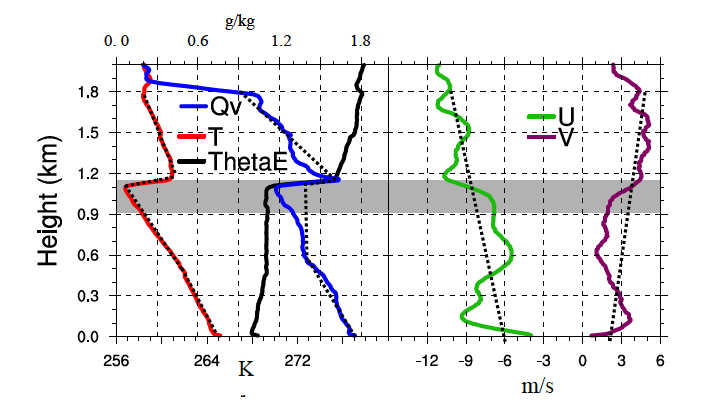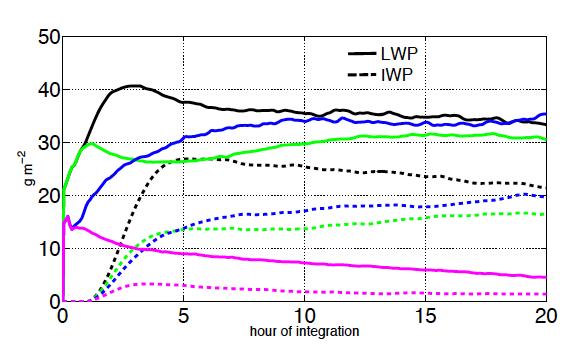Sensitivity of Arctic Mixed-Phase Stratocumulus to Surface-Layer and Cloud-Top Moisture Sources
Submitter:
Solomon, Amy — University of Colorado/NOAA- Earth System Research Laboratory
Shupe, Matthew — University of Colorado
Area of research:
Cloud Processes
Journal Reference:
Science
Arctic mixed-phase stratocumulus cloud systems (AMPS) play an important role in determining the structure of the Arctic atmospheric boundary layer and magnitudes of surface energy budget terms, due to the presence of radiatively important supercooled cloud liquid water. AMPS occur in significantly different environments than subtropical stratocumuli. For example, AMPS are observed above both stable surface boundary layers and open water, while subtropical stratocumulus typically occur over open ocean. Another difference between subtropical and Arctic stratocumulus is the Arctic specific humidity inversions are frequently observed to occur coincidentally with temperature inversions near cloud-top. This feature is due primarily to horizontal advection aloft and moisture depletion near the surface.
Previous studies based on observations and cloud-resolving models (Solomon et al. 2011) suggest humidity inversions play an important role in maintaining AMPS by providing moisture within the temperature inversion, which is entrained into the cloud system. Solomon et al. (2014) extends the findings of these previous studies by quantifying the relative role of cloud-top and subcloud-layer sources of moisture in the persistence of AMPS.
Impact
In Solomon et al. (2014), a series of idealized large-eddy simulations (LES) is used to investigate the relative impact of cloud top and subcloud-layer sources of moisture on the microphysical–radiative–dynamical feedbacks in an Arctic mixed-phase stratocumulus cloud system. This study is focused on a case derived from observations of a persistent single-layer AMPS cloud deck on 8 April 2008, during the Indirect and Semi-Direct Aerosol Campaign near Barrow, Alaska. Moisture and moist static energy budgets are used to examine the potential impact of ice in mixed-phase clouds, specific humidity inversions coincident with temperature inversions as a source of moisture for the cloud system, and the presence of cloud liquid water above the mixed-layer top.
Nested Weather Research and Forecasting simulations of this case performed with an inner grid at LES resolution (Solomon et al. 2011) demonstrate moisture is provided to the cloud system by a total water inversion at cloud-top, and the mixed layer is decoupled from surface sources of moisture. In addition, the nested simulations indicate cloud liquid water is maintained within the temperature inversion by down-gradient turbulent fluxes of water vapor from above and direct condensation driven by radiative cooling. These processes cause at least 20 percent of cloud liquid water to extend into the temperature inversion.
The LES studies of Solomon et al. (2014) demonstrate AMPS have remarkable insensitivity to changes in moisture source. When the overlying air is dried initially, radiative cooling and turbulent entrainment increase moisture import from the surface layer. When the surface layer is dried initially, the system evolves to a state with reduced mixed-layer water vapor and increased surface-layer moisture, reducing the loss of water through precipitation and entrainment of near-surface air. Only when moisture is reduced both above and below the mixed layer does the AMPS decay without reaching a quasi-equilibrium state.
Summary
A fundamental finding of this study is that, with or without cloud ice, and with or without a specific humidity inversion, the cloud layer eventually extends into the temperature inversion, producing a precipitation flux as a source of water into the mixed layer (above the mixed-layer top), producing a precipitation flux as a source of water into the mixed layer. This sedimentation into the mixed layer prevents the liquid water maximum from extending into the inversion, which increases radiative cooling at the mixed layer top, increasing turbulence in the mixed layer. This finding is opposite to subtropical stratocumulus-topped boundary layers where sedimentation reduces turbulence by moving liquid water downward from the inversion base.
In both Arctic and subtropical stratocumulus-topped boundary layers sedimentation can act to maintain the cloud layer, in the former by fluxing water into the cloud layer and the latter by reducing the mixing of dry inversion air into the cloud layer. The feedback between a cloud layer extending into the inversion, sedimentation into the mixed layer, and increased radiative cooling at mixed layer top is an example of processes that cause AMPS to be resilient.



